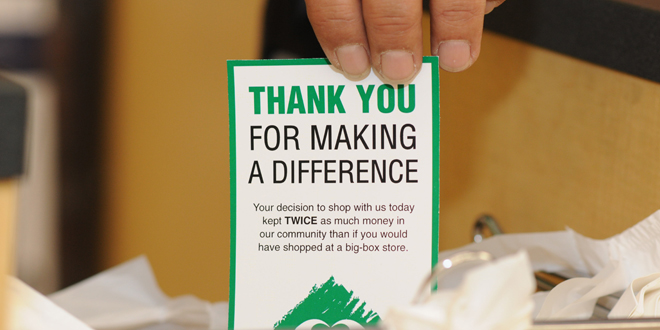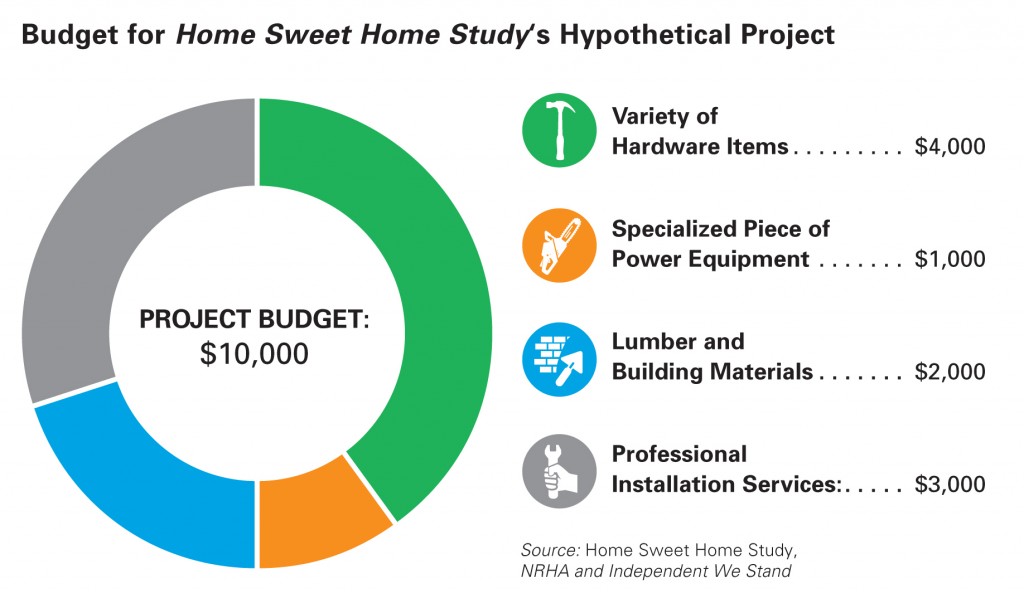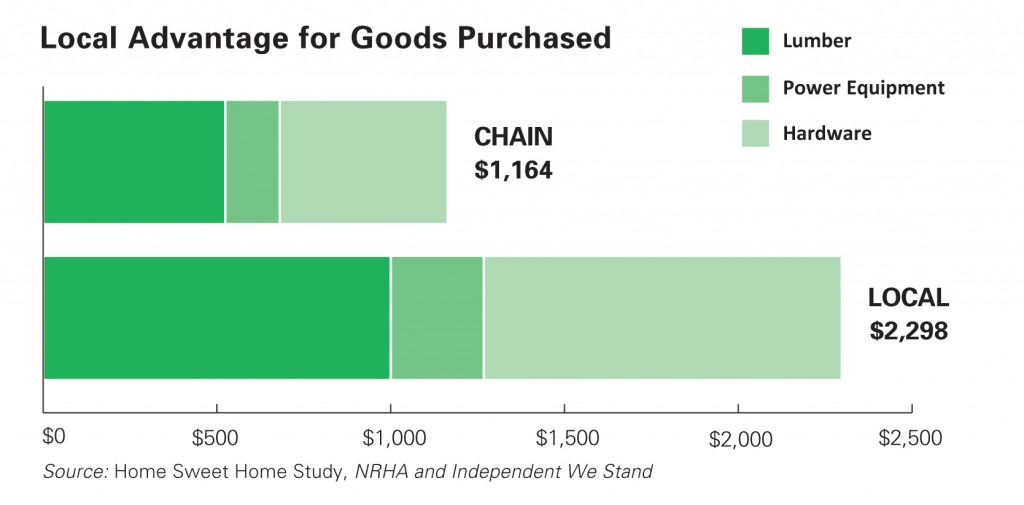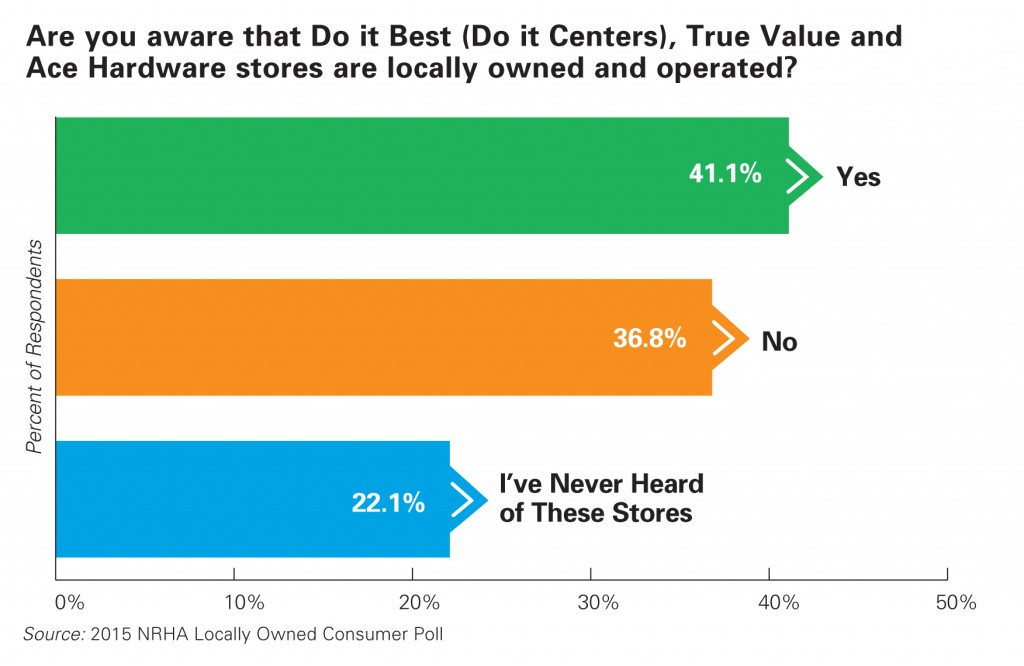To download a PDF of this story, click here. Visit hardwareretailing.com/shoplocal to download the marketing material presented in this story or download holiday-themed signage.
It’s a Fact: Shopping at Independent Home Improvement Retailers Builds Stronger Communities
By Kate Klein, kklein@nrha.org and Sara Logel slogel@nrha.org
Main Street used to serve as the go-to shopping district for products such as shoes, hardware and groceries, but metropolitan growth, the rise of mass merchants and rapid technological changes have transformed retailing and communities.
Awareness is growing, though, that spending money at a big-box store sends cash out of state and into the coffers of big corporations. A movement promoting local shopping has highlighted the financial impact independent businesses have on their communities and is sending shoppers back to Main Street.
Recent research shows that small businesses benefit their communities more than the mass merchants. Locally owned businesses are not only selling highquality products and often prioritizing goods made in America, but are also recirculating substantial amounts of money back into local economies.
Beginning in 2002, Civic Economics, an economic analysis and strategic planning firm, began its Indie Impact Study Series, which reveals the effect shopping at a local store versus a chain store has on a community.
The Indie Impact Study Series has analyzed 10 communities across the U.S, including Salt Lake City, Utah, and Raleigh, North Carolina. Civic Economics has also analyzed chains versus independent retailers on a national scale.
All of the study results have been similar: shopping at an independent retail store circulates more money back into a local economy than if the same amount is spent at a national chain.
The studies, to this point, have not been industry specific. However, the North American Hardware and Paint Association (NHPA) and Independent We Stand, an organization with a mission to inspire small business owners to discover their local roots and use them to encourage consumers to buy local, recently partnered to support research focusing on the home improvement industry. The result is the new Home Sweet Home Study, which examines the impact that shopping at a local home improvement store has on a community versus shopping at a big-box.
Independent We Stand created two videos that show the big impact small businesses make on their local communities. To view “Small Business. Big Impact.” click here and to view “Why Support Independent Business?” click here.
Below, we will explore the findings of the Home Sweet Home Study and share thoughts from leaders representing NHPA and Independent We Stand.
We will also explain new marketing material NHPA and Independent We Stand have created to help retailers use the results of the study to promote their businesses. This material, which includes signage, advertising content and other resources, is available to all independent retailers to educate customers on the benefits of purchasing home improvement products at local stores. The marketing materials featured below are free for all independent retailers to download at hardwareretailing.com/shoplocal.
Research & Findings
Methodology
Since a typical home improvement project involves a variety of goods and services, a hypothetical project approach was used to account for all home improvement categories. The budget for the hypothetical project was $10,000 and was divided among hardware, power equipment, lumber and building materials and professional installation services, as seen below. This budget provided opportunities to analyze various hardware and power tool segments from both independents and chains.
Civic Economics studied both independent and big-box businesses, examining the services and products that can be purchased at either. To determine a retailer’s “local economic impact,” the firm analyzed the different merchants’ labor costs, profits, procurement and charitable giving.
• Labor: A larger share of operating costs for local home improvement stores goes to labor since local stores’ administrative functions are either carried out in-house or outsourced to local providers. National chains consolidate these functions at their national headquarters.
• Profits: A larger portion of independent stores’ profits remain in a community. National chains redistribute profits to their shareholders or invest in global operations.
• Procurement: A local business will pay for local accounting and legal services. National chains provide these professional services in-house from their headquarters.
• Charitable Giving: Hometown businesses generally give back to their own communities. National chains are more likely to donate to national charities or groups located near their headquarters, not near their stores.
For this study, independent home improvement retailers provided their financial information for analysis. Lowe’s and Home Depot are publicly traded, so their financial documents are publicly available.
In addition, Civic Economics used NHPA’s 2014 Cost of Doing Business Study for further industry-specific financial data and STIHL, Inc., provided information about its power equipment sales.
The Results Are In
Shopping at a local home improvement store keeps more money in the local economy, but to what extent?
Below are the advantages of shopping at a local store versus a national chain for the four different project categories. At the end of the project, the homeowner will have initiated $1,250 in local economic activity simply by supporting local retailers. But that doesn’t capture the full economic advantage that shopping local provides.
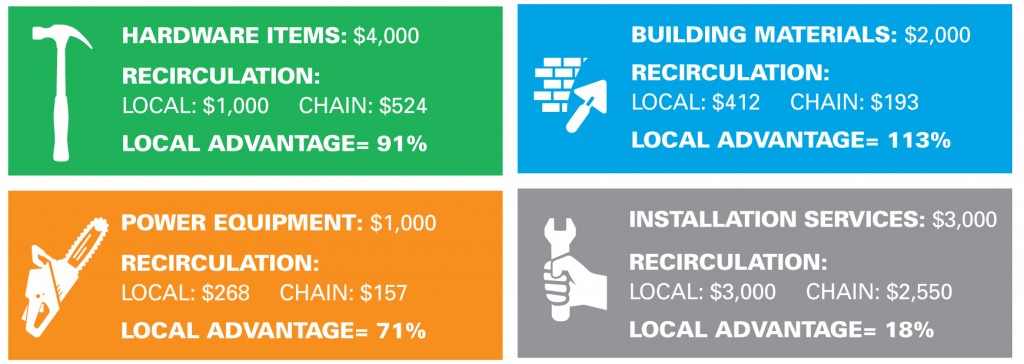
The most substantial impact can be seen from the purchase of goods. By purchasing $10,000 in products at a local store, $2,298 of the project would recirculate into a community whereas only $1,164 of that amount, when spent at major retail store chains, would. That’s a 97-percent advantage for local retailers, meaning two times as much money is kept in the community when products are purchased at a local retailer.
Installation services are almost always provided by local contractors, so that category, in relation to this research, is null. The reason local stores offer an 18-percent advantage for spending on installation services is because chain stores tend to retain about a 15-percent portion of the customer charge.
What These Findings Mean
Shopping at a local home improvement business provides a 97-percent local economic advantage, but what is the tangible impact for a community?
Think of it this way: If a shopper buys home improvement products from a local retailer, twice as much money goes toward local parks, Little League teams and bike path creation.
On a grander scale, the national impact potential is much bigger. Together, Lowe’s and Home Depot sold $114 billion in goods during 2013. If just 10 percent of that business had gone to independent stores, hometowns across the country would have enjoyed an additional $1.3 billion in economic activity that year.
Questions & Answers
We sat down with Dan Tratensek, vice president of publishing for NHPA, and Bill Brunelle, co-founder and managing partner of Independent We Stand. Here, they share insights from the Home Sweet Home Study and discuss ways to use the data to benefit independent home improvement retailers.
Tell us a little bit about the idea behind the study. What did you hope to achieve when you set out to conduct this research?
Bill: There is a growing body of research that demonstrates the strong economic impact that locally owned businesses have on local economies. However, none of the existing research looked specifically at the impact of supporting locally owned hardware, outdoor power equipment, paint and building materials retailers. Home improvement projects are generally big-ticket expenses for homeowners, and we wanted to show them what kind of impact they could have on their local economies if they sourced products and installation services from locally owned businesses.
Do you think the research achieved what you were hoping?
Dan: I definitely think the research illustrated that a dollar doesn’t always equal a dollar when it comes to local impact. Average consumers don’t necessarily think about the fact that when they spend money with a huge national chain, a good portion of those dollars flies right out of the local community and is redistributed to a corporation in a different state and ultimately to shareholders spread all over the world.
Were you surprised by any of the study findings? Why or why not?
Dan: I can’t say I was too surprised by what we found. I work closely with so many small business owners, and I realize what a major impact those businesses have on their communities. It’s about more than hiring local employees; it’s about buying their supplies from a local provider and using a local attorney’s office or accountant. It all adds up.
How will these study findings help retailers within the home improvement industry?
Dan: The study itself won’t likely be a surprise to most of the retailers who read this magazine. But now NHPA and Independent We Stand have some real hard numbers we can use to let the media and consumers know how important shopping at their local home improvement stores can be. We also hope retailers will help us spread the word about these findings by sharing them with their local media and customers.
How does the economic impact calculator make the study’s data even more useful?
Bill: The economic impact calculator uses the study’s findings to show consumers the dramatic impact they could have in their very own neighborhoods if they purchase home improvement products from locally owned retailers for one year.
Do you think this kind of research will resonate with consumers and impact their current shopping habits?
Bill: Yes, I think educated consumers care more and more every day about where their money goes and are willing to support local businesses that contribute to the health and prosperity of their communities.
Where do you see the shop-local movement heading in the future?
Bill: The shop-local movement has created a resurgence of support for local businesses. However, to borrow from a quote that Stacy Mitchell, co-director of the Institute for Local Self-Reliance made in a TEDx Talk, “We can’t just shop our way to a better economy.” Big-boxes and national chain retailers receive billions every year in economic development incentives and tax breaks while small businesses struggle to stay open. To make real change and real progress, we need to address government policies that are in place that put small local businesses at an extreme disadvantage.
Dan: Listen, we are realistic here. We know bigboxes can offer a value to consumers, and not every market has a robust independent retail community, but if we can just get more consumers considering a locally owned retailer as part of their shopping plans, it can make a big impact. None of these independently owned retailers are asking for consumers to shop at their stores as a sort of charity—they just want to make sure they remain part of the equation and they get a chance to earn consumers’ business.
What will NRHA and Independent We Stand do with this research to help drive business to independent retailers?
Dan: The biggest thing we plan to do is to spread the word about the findings. Shout it from the rooftops and talk to everyone who will listen. We also want to arm retailers with the information so they can make sure everyone in their local communities know what kind of impact they can make when they shop.
Marketing Material
Both NHPA and Independent We Stand are dedicated to helping independently owned businesses succeed, so it only made sense for the two organizations to join together on the Home Sweet Home Study.
While the study itself shows locally owned businesses deliver a meaningful financial impact to their communities, the numbers don’t mean much unless consumers realize the impact of where they choose to spend their dollars.
To help home improvement retailers leverage the data revealed by the Home Sweet Home Study, NHPA and Independent We Stand are offering a suite of resources, seen on the next page, that can be printed on window decals, posters and stickers, published as newspaper ads and shared on social media. Using the data and getting the word out that a store is locally owned can only benefit a business.
The majority of consumers surveyed recently don’t know that Do it Best, True Value and Ace Hardware stores are locally owned and operated. The new poll of 1,000 U.S. consumers, conducted by NHPA, shows that 37 percent of the respondents didn’t know those co-op stores were independently owned, and 22 percent had never heard of the brands.
The new data from the Home Sweet Home Study offers opportunities for retailers to educate consumers on who they are and then promote their hometown roots. Emphasizing the value of local ownership improves business because it motivates consumers to shop those stores first, according to retailers across the country.
Existing shop-local campaigns already help, so the new study provides even more information and resources to leverage.
Events such as Small Business Saturday, which was started by credit card company American Express, help bolster local shopping, according to Greg Gold, co-owner of two Miller’s Ace Hardware stores in Pennsylvania. On Small Business Saturday annually, he notices a 10- to 20-percent jump in store traffic, Gold says.
Ace Hardware and Stihl both provide signs and posters to encourage shopping local, and Gold uses those in the store, he says. Signs promote, for example, that his store has qualified employees who assemble power equipment. Miller’s Ace is active in promoting other community businesses, and contributes money, products and volunteer time to community efforts. Customers notice.
“We frequently get thanks from our customers for being here and being available to them. I think they value the fact that we’re local, we’re available and we’re convenient,” Gold says.
Pfeil Hardware & Paint in Troy, New York, hangs “Spend Where You Live” posters and promotes that the store is locally owned in its advertising. The community has responded supportively because the business is a local independent, and the store’s sales have increased every year.
“We’ve been open now for almost six years, and people still thank us for opening our store in downtown,” co-owner Deane Pfeil says. “They will go out of their way to shop local.”
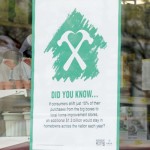 POSTERS
POSTERS
Hang this poster in a store window or on a checkout counter so it is visible and consumers can read about the economic benefits of shopping at your store.
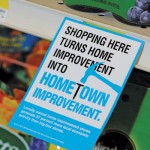 SHELF TALKERS
SHELF TALKERS
Print these small signs and display them at eye level throughout your business to educate consumers with quick tidbits from the Home Sweet Home Study.
 BAG STUFFERS
BAG STUFFERS
To further highlight the economic benefits your store offers, send a simple printout of data from the research home with every shopper.
 SOCIAL MEDIA MATERIAL
SOCIAL MEDIA MATERIAL
Share prewritten posts and photos on Facebook, Twitter and other social media platforms to publicize the financial benefits of spending at your store.
 CIRCULAR AND NEWSPAPER ADS
CIRCULAR AND NEWSPAPER ADS
Publish these customizable ads in your local newspaper or in your circulars. The ads are standard sizes so you can easily send them off for publishing.
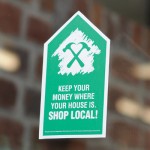 WINDOW DECAL
WINDOW DECAL
Stick these attractive window decals on glass surfaces in your business to share fast facts and reminders from the study with customers.
PRESS RELEASES
Two prewritten press releases allow you to share the study’s findings with local newspapers and magazines and to radio and TV stations. If local media outlets share the story of how your business benefits your community, then you will create buzz that not only promotes your store but also educates consumers with the best and latest industry research.
RADIO SCRIPT
Create a custom radio ad with this prewritten script, which is a 30-second information piece.
ONLINE CALCULATOR
The Home Sweet Home Economic Impact Calculator allows a consumer to type a ZIP code into the online tool to calculate the approximate dollar impact that buying products from a local home improvement retailer can have on a specific community. The numbers are specific to each ZIP code across the U.S.
This online calculator is available to add to your website to reinforce the message of the Home Sweet Home Study to your community. Since the calculator provides data that is specific to where you do business, it gives you solid numbers to use in advertising and other promotions to show consumers how important their decisions of where to shop are.
Download all of the marketing materials described on this page at hardwareretailing.com/shoplocal. We have also created additional marketing materials for Black Friday and the holidays.
 Hardware Retailing The Industry's Source for Insights and Information
Hardware Retailing The Industry's Source for Insights and Information



